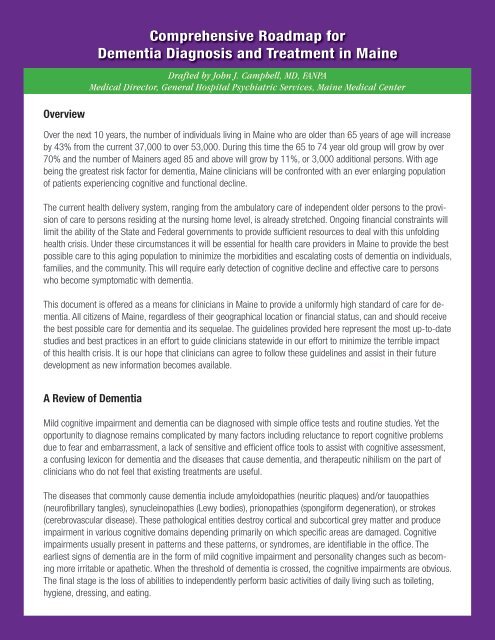State Plan for Alzheimer’s Disease and Related Dementias in Maine
State Plan for Alzheimer’s Disease and Related Dementias in Maine
State Plan for Alzheimer’s Disease and Related Dementias in Maine
Create successful ePaper yourself
Turn your PDF publications into a flip-book with our unique Google optimized e-Paper software.
Overview<br />
Comprehensive Roadmap <strong>for</strong><br />
Dementia Diagnosis <strong>and</strong> Treatment <strong>in</strong> Ma<strong>in</strong>e<br />
Drafted by John J. Campbell, MD, FANPA<br />
Medical Director, General Hospital Psychiatric Services, Ma<strong>in</strong>e Medical Center<br />
Over the next 10 years, the number of <strong>in</strong>dividuals liv<strong>in</strong>g <strong>in</strong> Ma<strong>in</strong>e who are older than 65 years of age will <strong>in</strong>crease<br />
by 43% from the current 37,000 to over 53,000. Dur<strong>in</strong>g this time the 65 to 74 year old group will grow by over<br />
70% <strong>and</strong> the number of Ma<strong>in</strong>ers aged 85 <strong>and</strong> above will grow by 11%, or 3,000 additional persons. With age<br />
be<strong>in</strong>g the greatest risk factor <strong>for</strong> dementia, Ma<strong>in</strong>e cl<strong>in</strong>icians will be confronted with an ever enlarg<strong>in</strong>g population<br />
of patients experienc<strong>in</strong>g cognitive <strong>and</strong> functional decl<strong>in</strong>e.<br />
The current health delivery system, rang<strong>in</strong>g from the ambulatory care of <strong>in</strong>dependent older persons to the provision<br />
of care to persons resid<strong>in</strong>g at the nurs<strong>in</strong>g home level, is already stretched. Ongo<strong>in</strong>g f<strong>in</strong>ancial constra<strong>in</strong>ts will<br />
limit the ability of the <strong>State</strong> <strong>and</strong> Federal governments to provide sufficient resources to deal with this unfold<strong>in</strong>g<br />
health crisis. Under these circumstances it will be essential <strong>for</strong> health care providers <strong>in</strong> Ma<strong>in</strong>e to provide the best<br />
possible care to this ag<strong>in</strong>g population to m<strong>in</strong>imize the morbidities <strong>and</strong> escalat<strong>in</strong>g costs of dementia on <strong>in</strong>dividuals,<br />
families, <strong>and</strong> the community. This will require early detection of cognitive decl<strong>in</strong>e <strong>and</strong> effective care to persons<br />
who become symptomatic with dementia.<br />
This document is offered as a means <strong>for</strong> cl<strong>in</strong>icians <strong>in</strong> Ma<strong>in</strong>e to provide a uni<strong>for</strong>mly high st<strong>and</strong>ard of care <strong>for</strong> dementia.<br />
All citizens of Ma<strong>in</strong>e, regardless of their geographical location or f<strong>in</strong>ancial status, can <strong>and</strong> should receive<br />
the best possible care <strong>for</strong> dementia <strong>and</strong> its sequelae. The guidel<strong>in</strong>es provided here represent the most up-to-date<br />
studies <strong>and</strong> best practices <strong>in</strong> an ef<strong>for</strong>t to guide cl<strong>in</strong>icians statewide <strong>in</strong> our ef<strong>for</strong>t to m<strong>in</strong>imize the terrible impact<br />
of this health crisis. It is our hope that cl<strong>in</strong>icians can agree to follow these guidel<strong>in</strong>es <strong>and</strong> assist <strong>in</strong> their future<br />
development as new <strong>in</strong><strong>for</strong>mation becomes available.<br />
A Review of Dementia<br />
Mild cognitive impairment <strong>and</strong> dementia can be diagnosed with simple office tests <strong>and</strong> rout<strong>in</strong>e studies. Yet the<br />
opportunity to diagnose rema<strong>in</strong>s complicated by many factors <strong>in</strong>clud<strong>in</strong>g reluctance to report cognitive problems<br />
due to fear <strong>and</strong> embarrassment, a lack of sensitive <strong>and</strong> efficient office tools to assist with cognitive assessment,<br />
a confus<strong>in</strong>g lexicon <strong>for</strong> dementia <strong>and</strong> the diseases that cause dementia, <strong>and</strong> therapeutic nihilism on the part of<br />
cl<strong>in</strong>icians who do not feel that exist<strong>in</strong>g treatments are useful.<br />
The diseases that commonly cause dementia <strong>in</strong>clude amyloidopathies (neuritic plaques) <strong>and</strong>/or tauopathies<br />
(neurofibrillary tangles), synucle<strong>in</strong>opathies (Lewy bodies), prionopathies (spongi<strong>for</strong>m degeneration), or strokes<br />
(cerebrovascular disease). These pathological entities destroy cortical <strong>and</strong> subcortical grey matter <strong>and</strong> produce<br />
impairment <strong>in</strong> various cognitive doma<strong>in</strong>s depend<strong>in</strong>g primarily on which specific areas are damaged. Cognitive<br />
impairments usually present <strong>in</strong> patterns <strong>and</strong> these patterns, or syndromes, are identifiable <strong>in</strong> the office. The<br />
earliest signs of dementia are <strong>in</strong> the <strong>for</strong>m of mild cognitive impairment <strong>and</strong> personality changes such as becom<strong>in</strong>g<br />
more irritable or apathetic. When the threshold of dementia is crossed, the cognitive impairments are obvious.<br />
The f<strong>in</strong>al stage is the loss of abilities to <strong>in</strong>dependently per<strong>for</strong>m basic activities of daily liv<strong>in</strong>g such as toilet<strong>in</strong>g,<br />
hygiene, dress<strong>in</strong>g, <strong>and</strong> eat<strong>in</strong>g.<br />
25


